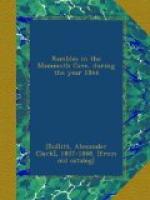The little bells of the brain are ringing in your
ears; you hear nothing else—not even a sigh
of air—not even the echo of a drop of water
falling from the roof. The guide triumphs in
your look of amazement and awe; he falls to work on
certain old wooden ruins, to you, yet invisible, and
builds a brace or two of fires, by the aid of which
you begin to have a better conception of the scene
around you. You are in the vestibule or ante-chamber,
to which the spacious entrance of the Cave, and the
narrow passage that succeeds it, should be considered
the mere gate-way and covered approach. It is
a basilica of an oval figure—two-hundred
feet in length by one-hundred and fifty wide, with
a roof which is as flat and level as if finished by
the trowel of the plasterer, of fifty or sixty or
even more feet in height. Two passages, each
a hundred feet in width, open into it at its opposite
extremities, but at right angles to each other; and
as they preserve a straight course for five or six-hundred
feet, with the same flat roof common to each, the
appearance to the eye, is that of a vast hall in the
shape of the letter L expanded at the angle, both branches
being five-hundred feet long by one-hundred wide.
The passage to the right hand is the “Great
Bat Room;” (Audubon Avenue.) That in the front,
the beginning of the Grand Gallery, or the Main Cavern
itself. The whole of this prodigious space is
covered by a single rock, in which the eye can detect
no break or interruption, save at its borders, where
is a broad, sweeping cornice, traced in horizontal
panel-work, exceedingly noble and regular; and not
a single pier or pillar of any kind contributes to
support it. It needs no support. It is like
the arched and ponderous roof of the poet’s
mausoleum:
“By its own weight made
stedfast and immoveable.”
The floor is very irregularly broken, consisting of
vast heaps of the nitrous earth, and of the ruins
of the hoppers or vats, composed of heavy planking,
in which the miners were accustomed to leach it.
The hall was, in fact, one of their chief factory
rooms. Before their day, it was a cemetery; and
here they disinterred many a mouldering skeleton,
belonging it seems, to that gigantic eight or nine
feet race of men of past days, whose jaw-bones so
many vivacious persons have clapped over their own,
like horse-collars, without laying by a single one
to convince the soul of scepticism.
Such is the vestibule of the Mammoth Cave,—a
hall which hundreds of visitors have passed through
without being conscious of its existence. The
path, leading into the Grand Gallery, hugs the wall
on the left hand; and is, besides, in a hollow, flanked
on the right hand by lofty mounds of earth, which
the visitor, if he looks at them at all, which he
will scarcely do, at so early a period after entering,
will readily suppose to be the opposite walls.
Those who enter the Great Bat Room, (Audubon Avenue,)
into which flying visitors are seldom conducted, will
indeed have some faint suspicion, for a moment, that
they are passing through infinite space; but the walls
of the Cave being so dark as to reflect not one single
ray of light from the dim torches, and a greater number
of them being necessary to disperse the gloom than
are usually employed, they will still remain in ignorance
of the grandeur around them.




